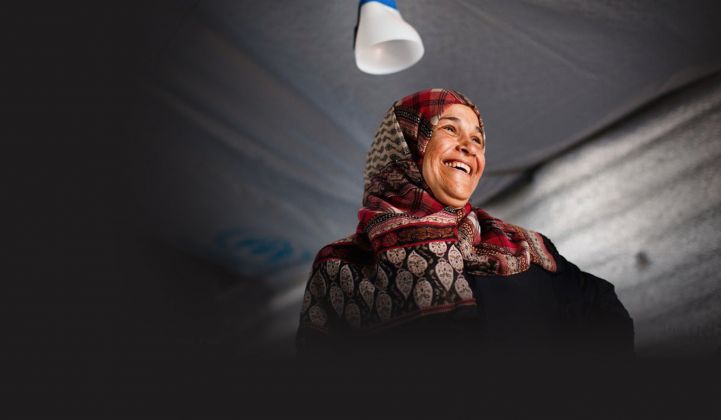The Azraq refugee camp is located on a bleak stretch of desert in northern Jordan. The camp is currently home to 28,000 Syrian refugees, but is built to host nearly double that amount and could soon see a massive influx of residents as the conflict in Syria drags on.
There is currently no electricity at Azraq. Donations have allowed the United Nations to provide families with small solar-powered lanterns, but they’re hardly enough to live by. The lack of electricity makes it hard for children to learn and for families to cook, and it puts camp residents, especially women, in danger.
But next year, there will be light. The U.N. Refugee Agency recently announced plans to build a 6-megawatt grid-connected solar project at the Azraq camp through a partnership with Ikea.
The Jordanian solar company Mustakbal was selected to build the project from among 25 bidders in a public international tender. Refugees will be employed to help build the solar farm, with the first 2 megawatts expected to come on-line by the middle of 2016.
“Light is absolutely essential,” said Anne-Marie Grey, the executive director and CEO of USA for UNHCR, in an interview. “When you go into a camp, you realize how it’s a safety issue as much as a right to light or a right to energy issue.”
In addition to light, the solar project will enable residents to charge their cell phones, which is often the only way refugees can keep in touch with their loved ones. Cell phones are also critically important for U.N. representatives operating in crisis zones.
The Azraq solar array is being funded entirely by Ikea through the Brighter Lives for Refugees campaign. The program, now in its third and final year, seeks to improve the lives of refugees around the world by providing access to sustainable energy supplies. This year, the purchase of any lamp or light bulb at an Ikea store between November 29 and December 19 will result in a $1 donation to the refugee initiative.
“This camp [Azraq] has given us a chance to survive in safety, but providing electricity here would give us another chance at life,” said Emtyaz, a Syrian refugee and mother of three.
An $800,000 monthly energy bill
While the Azraq solar array comes in response to a specific crisis, it isn’t a one-off project. Rather, it’s part of a broader shift toward the adoption of clean energy in developing areas.
The precipitous cost decline of solar PV has made it possible to undertake projects like this, said Paul Quigley, senior energy officer at UNHCR. The economics are particularly attractive in sunny places with high electricity prices.
In Jordan, electricity from the grid costs around 42 cents per kilowatt-hour, he said. At one point, the U.N. was paying more than $800,000 per month to power the Zaatari refugee camp -- the primary refugee camp in Jordan that’s often shown in the news. “It does not make sense to pay that sort of bill,” said Quigley.
To help cut down expenses, the German government is funding a 10-megawatt solar project at Zaatari. The project is scheduled to come on-line next year.
At Azraq, the 6-megawatt solar project has a total price tag of $10 million, but will pay for itself in just two to four years and nearly eliminate all electricity expenses from that point on.
As the economic case for renewables improves, the need for electricity continues to grow. UNHCR alone is dealing with 60 million people that are either displaced, refugees or stateless, which means they don’t hold any kind of citizenship status. And while the organization was originally set up to deal with emergencies, UNHCR's role is changing now that it sees people spending an average of 17 years at a refugee camp.
“By year five, it’s no longer an emergency,” said Grey. “It’s a long-term, protracted situation that requires different kinds of intervention, such as access to energy.”
The Azraq project is actually one of the U.N.’s first grid-connected renewable energy projects. Traditionally, host governments have opposed setting up any kind of permanent structures at refugee camps out of fear that it would draw more refugees in. But as refugee camps have turned into full-fledged cities, a new approach has become necessary.
“A solar lamp just isn’t going to cut it for too long,” said Grey.
In a perfect world, the Azraq solar project will outlast the refugee camp, she added. At that point, the array would be turned over to the Jordanian government to serve the local population.
A business opportunity
As the Paris climate talks have highlighted, there is a dire need for electricity across much of the developing world. Fatih Birol, executive director of the International Energy Agency, noted in a recent presentation that for every $3 invested in Africa’s energy sector, $2 is used for the export of African energy resources and just $1 is used for domestic projects, even as 600 million people in Africa live without electricity.
“Clearly, there is a huge opportunity for governments, for development organizations, and for the private sector to figure out how to bring energy and work in supporting those who are bringing energy to a continent like Africa,” said Grey.
Several U.S. companies have already expressed interest in working with the U.N. on international energy projects. SunEdison, for instance, has bid to work on solar projects in Jordan.
But the U.N. is eager to establish stronger ties with the private sector in order to find better, cheaper deals, according to Quigley. Next year, the organization will launch an initiative to do more corporate outreach and find new ways to advertise tenders for clean energy projects.
“So many people come to us with a fabulous technology for things like improving education. And I think, 'This is great, but we don’t have electricity to recharge laptops and we don’t have connectivity,'" said Grey. "So we need first things first."
“That’s a business opportunity,” she added. “Especially when it comes to energy.”



